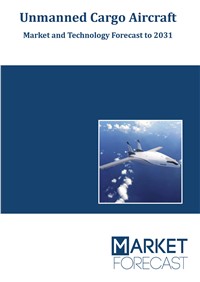The unmanned cargo aircraft market includes autonomous drones (quadcopters), autonomous fixed wing aircraft, and autonomous helicopters that are used to carry cargo payloads.
Air cargo services have been around for over a century. Initially it was used to transport mail and light packages, but it had quickly evolved into the transportation of heavy civilian and military cargo across continents, once large airliners started operating.
The development of the Unmanned Aerial Vehicle (UAV) technologies has expanded their range of applications offering civilian and military users the ability to operate them in cargo transportation roles. This expansion has led to a whole new market of unmanned aerial logistics vehicles called the Unmanned Cargo Aircraft Market, which led to the formation of new companies, predominantly start-ups.
The report “Unmanned Cargo Aircraft - Market and Technology Forecast to 2031” examines, analyses, and predicts the evolution of unmanned cargo aircraft technologies, markets, and outlays (expenditures) over the next nine years – 2023-2031 in the aerospace industry. It also examines unmanned cargo aircraft markets geographically, focusing on the top 95% of global markets, in the Americas, Europe, Asia Pacific, and Middle East & Africa.
Throughout the report we show how unmanned cargo aircraft are used today to add real value, as well as how will they be used in the near and distant future. To provide the most thorough and realistic forecast, this report provides a twin-scenario analysis.
Covered in this report
- Overview: Snapshot of the unmanned cargo aircraft market during 2023-2031, including highlights of the demand drivers, trends, and challenges. It also provides a snapshot of the spending with respect to regions as well as segments and sheds light on the emergence of new technologies.
- Market Dynamics: Insights into the technological developments in the unmanned cargo aircraft market and a detailed analysis of the changing preferences of governments around the world. It also analyses changing industry structure trends and the challenges faced by the industry participants.
- Segment Analysis: Insights into the various application, propulsion, and end user markets from a segmental perspective and a detailed analysis of factors influencing the market for each segment.
- Regional Review: Insights into use case patterns and commercialisation of the technology for top countries within a region.
- Regional Analysis: Insights into the application market from a regional perspective and a detailed analysis of factors influencing the market for each region.
- Impact Analysis: Analysis on how certain events will impact the unmanned cargo aircraft market. This will give you an indication on which factors are important for the forecast.
- Key Program Analysis: Details of the top programs in each segment expected to be executed during the forecast period.
- Competitive landscape Analysis: Analysis of competitive landscape of this industry. It provides an overview of key companies, together with insights such as key alliances, strategic initiatives, and a brief financial analysis.
Segmentation
We have segmented the market by Region, Application, Propulsion, and End User.Region
- Americas
- Europe
- Asia
- Middle East & Africa
- E-Commerce, Parcel, & Postal Delivery
- Military & Homeland Security (HLS)
- Healthcare & Humanitarian
- Industrial & Maritime
- Fuel
- Hybrid
- Electric
- Commercial
- Military & Civil Services
Reasons to buy
- Determine prospective investment areas based on a detailed trend analysis of the global unmanned cargo aircraft industry over the next eight years.
- Gain in-depth understanding about the underlying factors driving demand for different application segments in the top spending countries across the world and identify the opportunities offered by each of them.
- Strengthen your understanding of the market in terms of demand drivers, industry trends, and the latest technological developments, among others.
- Identify the major channels that are driving the global unmanned cargo aircraft business, providing a clear picture about future opportunities that can be tapped, resulting in revenue expansion.
- Channelise resources by focusing on the ongoing programs that are being undertaken by the ministries of different countries within the unmanned cargo aircraft market.
- Make correct business decisions based on thorough analysis of the total competitive landscape of the sector with detailed profiles of the top platform providers around the world which include information about their products, alliances, recent contract wins and financial analysis wherever available.




